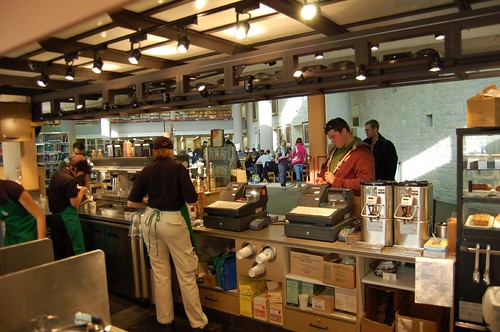Last Updated on July 14, 2011, 9:02 pm ET
In a recent “Soapbox” column for Publishers Weekly, Tom Allen of the Association of American Publishers seems to suggest that the academic publishing ecosystem may suffer grave harm due to libraries relying on fair use to make excerpts from library collections available to students on electronic platforms. If libraries don’t pay additional licensing fees for arguably fair uses, the academic ecosystem is somehow at risk. Indeed, Mr. Allen even echoes a familiar charity pitch to make his point: for the cost of a cup of coffee (per student), libraries can keep a starving academic publishing industry alive.
At the University of Manitoba, students can buy their own Starbucks coffee, inside the library.
Let’s be clear: libraries lawfully acquire all of the books, serials, and other resources they make available to students. The question is, once libraries pay to get these materials into their collections, must they pay again and again for legitimate educational uses? Members of Mr. Allen’s organization (the Association of American Publishers, which, along with the Copyright Clearance Center, is funding the lawsuit against Georgia State University over just this question), would like to charge libraries and universities a second time (and a third time, and a fourth time, ad infinitum) for the use of materials they’ve already lawfully purchased or licensed. Indeed, as Paul Courant has observed, libraries often obtain broad electronic rights as part of their existing licensing agreements, so in many instances they are already paying for precisely the permissions that blanket licenses purport to provide.
It is therefore worth asking how much money libraries spend in the first place on building their collections. Are libraries underinvesting in scholarly publishing, or scaling back their investments overall?
For years ARL has collected statistics on university library expenditures for materials, and the numbers suggest libraries are in fact quite generous with their investments in academic publishing. Publishers might like to make even more money from libraries, but our surveys suggest that if publishers are enduring great hardship, it cannot be due to library disinvestment. Libraries have never spent more on materials than they do now, and their spending has increased at a dramatic rate over the years.
According to the latest ARL survey data (which hasn’t been published, yet, but should be released later this year), member university libraries collectively spent over $1.3 billion on licensing and purchasing new materials in the 2009-10 survey period. That’s billion with a “b.” Median library expenditures on serials and monographs have more than tripled since 1986, and have gone steadily up in that time period. In other words, libraries are injecting huge sums of money into the academic publishing ecosystem today. You can see last year’s data, which shows similar totals and the same trends, here (key data is at page 46 of the PDF).
Unlike other players in the content marketplace, academic publishers have customers that are willing to pay more and more for content that is becoming ever cheaper and easier to create and distribute. In addition to library acquisitions, publishers are still charging notoriously large sums for textbooks, and (unless things have changed dramatically since I was a college student) selling plenty of monographs to students, too. And academic publishers can rely on universities to pay their authors (and in many cases, their editors and peer reviewers) salaries, making royalties (if there are any) an afterthought.
The spiraling growth in the cost of library acquisitions, especially electronic resources like serials (which have ballooned dramatically in absolute cost and as a proportion of library expenditures over the last decade) points to another problem with Mr. Allen’s “cost of a cup of coffee” argument: once libraries surrender their fair use rights and start paying for a license, what assurance do they have that these license fees will not also increase exponentially over time?
These new license fees could be a real hardship, especially for smaller, less well-off institutions. Some institutions simply will not be able to pay for these licenses (or the cost of administering them). Despite having lawfully acquired content and lawfully acquired platforms for using that content, they will not be able to afford to provide the same kind of cutting edge learning experiences that are available elsewhere. As Madelyn Wessell and Deborah Gerhardt argue in their important article Fair Use and Fairness On Campus, the erosion of fair use rights and their replacement with costly licensing schemes widens the digital divide and needlessly exacerbates existing inequalities in educational opportunity.
Ultimately, the facts paint a very different picture from the one Mr. Allen outlined in his editorial. Library investment in academic resources has never been more robust. And, as any Starbucks addict can tell you, the cost of a cup of coffee can be very high, indeed, once you get in the habit of paying it over and over again.




